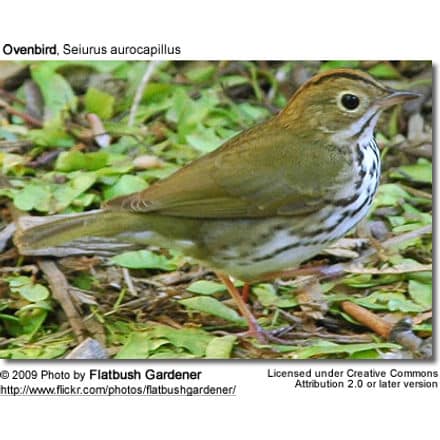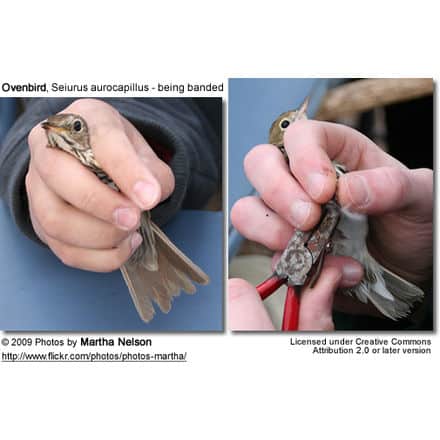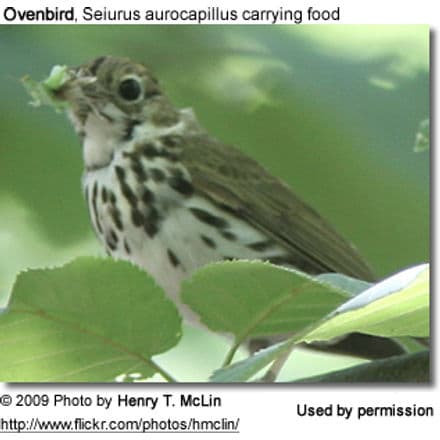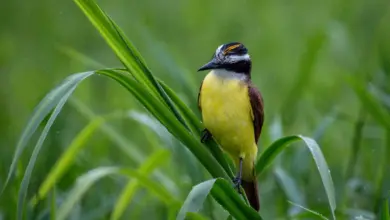Ovenbird (Seiurus aurocapillus)
Ovenbird, (Seiurus aurocapillus) are small, thrushlike songbirds found in Mexico, and Central and South America. They were named for their leaf-covered dome nests that resemble outdoor ovens.
They are also commonly referred to as el horneros ( house builders) as they use clay or mud mixed with fibers or hair to construct their nests.

Description
Ovenbird are somewhat smaller than Song Sparrows; they average 14 cm in length and weigh about 18 grams.
Below they are white with black streaks. Above they are olive brown. There are orange lines on the top of their crowns, with dark brown borders on the sides.
These birds have conspicuous white eye rings, flesh-colored legs, and thin pointed bills.
Distribution
Their breeding habitats are mature deciduous and mixed forests, especially sites with less undergrowth, which can be found across Canada and the eastern United States.
Ovenbird migrate to the southeastern United States, the West Indies, and from Mexico to northern South America.
This bird seems just capable of crossing the Atlantic, as there have been a handful of records in Norway, Ireland, and Great Britain.
However, half of the six finds were of dead birds. A live Ovenbird on St Mary’s, Isles of Scilly in October 2004 was taken into care, as it was in bad condition.

Diet / Feeding
The diet consists of insects, spiders, and snails. In winter, they also take fruit.
Prey is taken from the ground or caught in mid-air.
Nesting / Breeding
The nest is a domed structure with a side entrance. The nest is also referred to as “Oven” (hence this species’ common name). It is woven from vegetation and placed on the ground.
Both parents feed and protect the chicks.
Calls / Vocalizations
Songs: described as noisy teacher-teacher-teacher or erteach-erteach-erteach
Call: dry chut
Species
- Miners – Genus Geositta – South America
- Leaftossers – Genus Sclerurus – Mexico, Central and South America
- Woodcreepers – Central and South America
- Genera Dendrocolaptes / Hylexetastes / Dendrocincla / Xiphocolaptes / Xiphorhynchus
- Genus Deconychura (Long-tailed Woodcreeper)
- Genus Sittasomus – Olivaceous Woodcreeper
- Genus Certhiasomus – Spot-throated Woodcreeper
- Genus Glyphorynchus – Wedge-billed Woodcreeper
- Genus Nasica – Long-billed Woodcreeper
- Genus Dendrexetastes – Cinnamon-throated Woodcreeper
- Genus Dendroplex – Straight-billed Woodcreepers
- Genus Lepidocolaptes – Narrow-billed Woodcreepers
- Genus Drymornis – Scimitar-billed Woodcreeper
- Scythebills – Central and South America
- Genus Campylorhamphus
- Genus Drymotoxeres – Greater Scythebill
- Foliage-gleaners – Central and South America
- Genus Anabazenops
- Genus Philydor
- Genus Anabacerthia
- Genus Syndactyla
- Genus Hylocryptus
- Genus Automolus
- Buff-throated Foliage-gleaner (Automolus ochrolaemus)
- Treerunners – Central and South America
- Genus Margarornis
- Genus Pygarrhichas – White-throated Treerunner
- Treehunters – Central and South America
- Genus Thripadectes
- Genus Cichlocolaptes – Pale-browed Treehunter
- Genus Heliobletus – Sharp-billed Treehunter
- Spinetails – North, Central and South America
- Genus Cranioleuca – Typical Spinetails
- Genera Certhiaxis / Synallaxis / Poecilurus
- Genus Schoeniophylax – Chotoy Spinetail
- Genus Hellmayrea – White-browed Spinetail
- Genus Spartonoica – Bay-capped Wren-Spinetail
- Genus Leptasthenura – Tit-spinetails
- Barbtails– Central and South America
- Genus Premnoplex – Typical Barbtails
- Genus Premnornis – Rusty-winged Barbtail
- Genus Roraimia – Roraiman Barbtail
- Earthcreepers – South America
- Genera Ochetorhynchus and Upucerthia
- Genus Geocerthia – Striated Earthcreeper
- Xenops – Mexico, Central and South America
- Genus: Xenops
- Genus Megaxenops – Great Xenops
- Genus Rufous-tailed Xenops
- Reedhaunters – South America
- Genus Limnoctites – Straight-billed Reedhaunter
- Genus Limnornis – Curve-billed Reedhaunter
- Canasteros – South America
- Genus Asthenes
- Genus Pseudasthenes – “false canasteros”
- Misc.
- Genus Tarphonomus – South Central America
- Genus Cinclodes – South America
- Genus Furnarius – Horneros – South America
- Genus Aphrastura – Rayaditos – Chile, South America /South American Islands
- Genus Pseudoseisura – Cacholotes – South America
- Genus Thripophaga – Softtails – South America
- Genus Phacellodomus – Thornbirds – South America
- Genus Pseudocolaptes –Tuftedcheeks – Central and South America
- Genus Xenerpestes – Graytails – Central and South America
- Genus Lochmias – Sharp-tailed Streamcreeper – South America
- Genus Phleocryptes – Wren-like Rushbird – South America
- Genus Ancistrops – Chestnut-winged Hookbill – South America
- Genus Clibanornis – Canebrake Groundcreeper – South America
- Genus Hyloctistes – Striped Woodhaunter – Central and South America
- Genus Sylviorthorhynchus – Des Murs’s Wiretail – South America
- Genus Anumbius – Firewood-gatherer – South America
- Genus Coryphistera – Lark-like Brushrunner – South America
- Genus Siptornis – Spectacled Prickletail – South America
- Genus Metopothrix – Orange-fronted Plushcrown – South America
- Genus Acrobatornis – Pink-legged Graveteiro – South America
- Genus Berlepschia – Point-tailed Palmcreeper – South America






